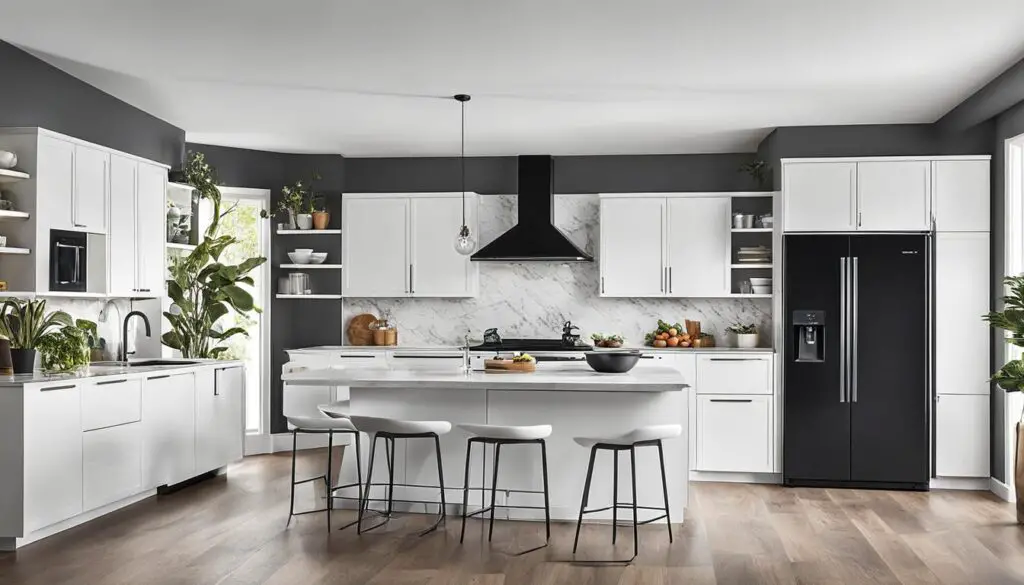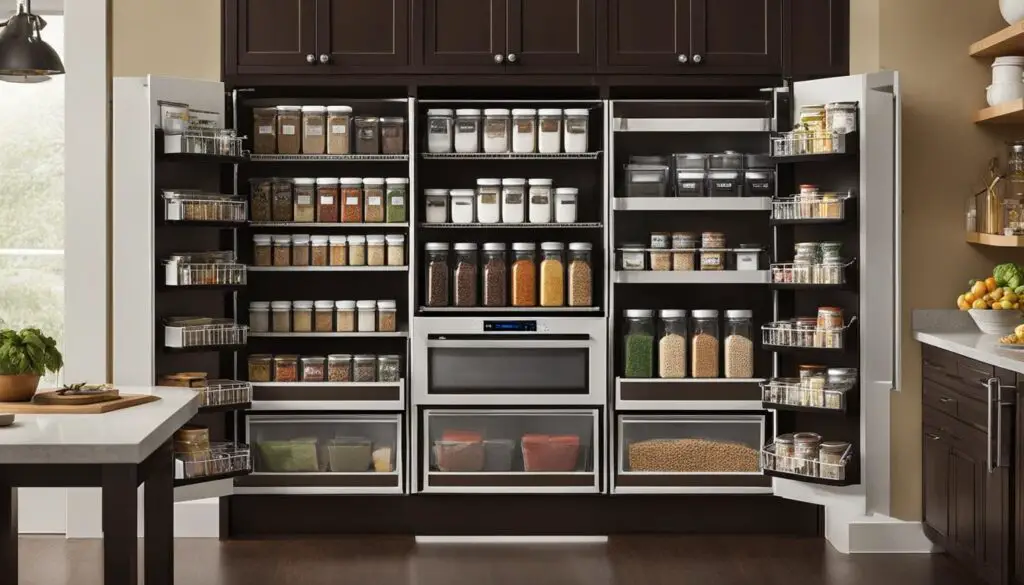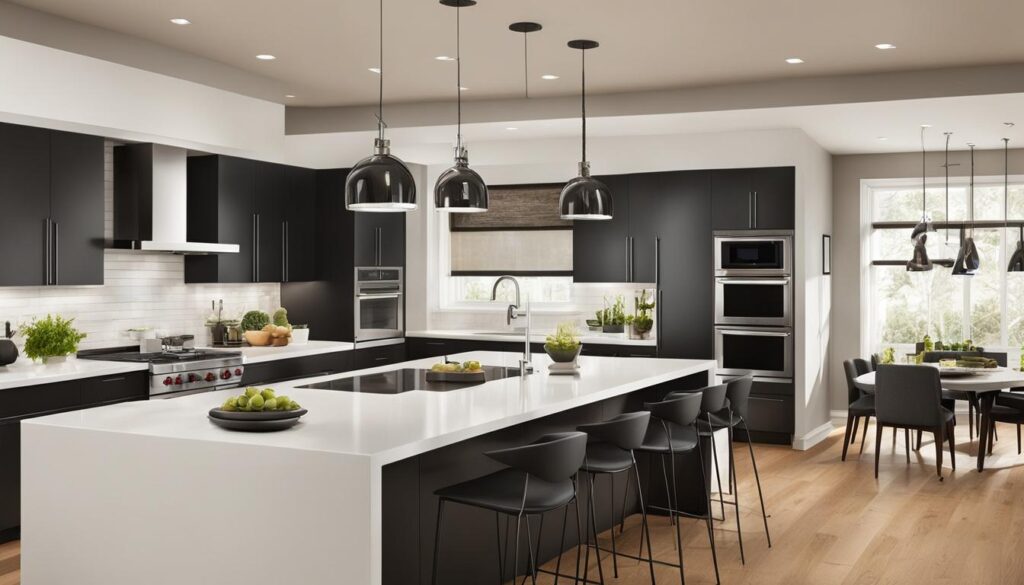As a tech enthusiast and someone who loves spending time in the kitchen, I have always been excited about the idea of creating a beginner-friendly smart kitchen. Imagine a cooking space that seamlessly combines technology and convenience, making your culinary adventures both efficient and enjoyable. If you’re ready to upgrade your kitchen and embark on a journey to a tech-savvy cooking space, then you’re in the right place! In this article, I will share some practical tips and insights on how to build a beginner-friendly smart kitchen that will revolutionize your cooking experience.
With the help of smart appliances, gadgets, and strategic planning, you can transform your kitchen into a hub of efficiency, where every task becomes a breeze. From planning your kitchen layout to choosing the right appliances and integrating them into your smart home system, we will cover every aspect of creating a beginner-friendly smart kitchen. Get ready to embrace the limitless possibilities of technology in the heart of your home!
Table of Contents
Key Takeaways:
- Building a beginner-friendly smart kitchen involves combining technology and convenience.
- Smart appliances and gadgets can revolutionize your cooking experience.
- Plan your kitchen layout to prioritize functionality and ergonomics.
- Integrate your smart kitchen with your existing smart home system for a seamless experience.
- Organize your kitchen space to maximize efficiency.
Planning Your Kitchen Layout
When it comes to building a beginner-friendly smart kitchen, one of the key considerations is the layout of your space. A well-planned kitchen layout is essential for ensuring that your cooking area is efficient, ergonomic, and functional.
When designing your kitchen layout, it’s important to take into account the principles of ergonomics. Ergonomics focuses on creating a space that is comfortable and minimizes strain on the body. This involves considering factors such as the height of countertops and cabinets, the placement of appliances, and the flow of movement within the space.
The Three Main Kitchen Layouts
There are three primary kitchen layouts to consider: the L-shaped layout, the U-shaped layout, and the galley layout. Each layout has its own advantages and can be tailored to suit your specific needs and preferences.
| L-Shaped Layout | U-Shaped Layout | Galley Layout |
|---|---|---|
| An L-shaped layout provides a functional and efficient workspace, with two adjacent walls forming an L shape. This layout offers ample countertop and storage space, making it ideal for both small and large kitchens. | A U-shaped layout features three walls of cabinetry and appliances, forming a U shape. This layout offers plenty of counter space and storage, allowing for smooth workflow and easy access to different areas of the kitchen. | A galley layout consists of two parallel walls with a walkway in between. This layout maximizes efficiency by creating a streamlined workflow. It is particularly suitable for narrow kitchens or open-concept spaces. |
When planning your kitchen layout, it’s important to consider the functionality of the space. Think about how you use your kitchen and the tasks you frequently perform. This will help you determine the placement of appliances, workstations, and storage areas to optimize functionality and enhance your cooking experience.
Remember, a well-planned kitchen layout not only improves the efficiency of your cooking process but also makes it more enjoyable and convenient.
By carefully considering the ergonomics and functionality of your kitchen layout, you can create a space that is not only aesthetically pleasing but also practical and efficient. This will set the foundation for building a beginner-friendly smart kitchen that seamlessly integrates technology and enhances your overall cooking experience.
Choosing Smart Appliances
One of the key elements of a beginner-friendly smart kitchen is the incorporation of smart appliances. These appliances offer automation and connectivity features that simplify your cooking experience.
When selecting smart appliances for your kitchen, consider the following factors:
- Remote Control: Look for appliances that can be controlled remotely, allowing you to monitor and adjust settings even when you’re not in the kitchen.
- Built-in Timers and Presets: Opt for appliances with built-in timers and presets, making it convenient to set cooking times and temperatures with just a few taps on your smartphone or voice commands.
- Energy Efficiency: Choose appliances that offer energy efficiency features, such as smart sensors that optimize power usage and reduce energy consumption.
By selecting smart appliances with these features, you can create a kitchen that is not only technologically advanced but also more convenient and efficient.
To give you an idea of the smart appliances available on the market, here is a table showcasing some popular options:
| Smart Appliance | Features |
|---|---|
| Smart Refrigerator |
|
| Smart Oven |
|
| Smart Coffee Maker |
|
| Smart Dishwasher |
|
These smart appliances bring automation, connectivity, and convenience to your kitchen, making cooking and meal preparation a breeze.

Smart Home Integration
Integrating your smart kitchen with your existing smart home system is essential for a seamless and user-friendly experience. By connecting your smart appliances and devices, you can create a fully integrated cooking space that offers convenience and efficiency.
When integrating your smart kitchen, it’s important to ensure compatibility with popular smart home platforms. Look for appliances that support platforms like Amazon Alexa, Google Assistant, or Apple HomeKit. This compatibility allows you to control your kitchen appliances through voice commands, making cooking even easier and more hands-free.
Voice Control for Hands-Free Operation
One of the key advantages of smart home integration is the ability to use voice commands to control your kitchen appliances. By incorporating voice control technology, such as Amazon Echo or Google Home, you can effortlessly manage your smart kitchen with just your voice.
Imagine being able to preheat your oven, brew coffee, or change the lighting in your kitchen, all without lifting a finger. Voice control technology enables you to perform these tasks and more, making your cooking experience more convenient and efficient.
“Hey Google, preheat the oven to 350 degrees.”
With voice control, you can also access additional features and functionalities of your smart appliances. For example, you can ask for recipe recommendations, set timers, or adjust cooking settings, all through simple voice commands. This hands-free operation allows you to focus on the task at hand and eliminates the need for manual control.
Seamless Compatibility with a Variety of Devices
Smart home integration ensures that your kitchen appliances work smoothly together and can be easily controlled from a central hub or app. This compatibility extends to a wide range of devices, including smartphones, tablets, smartwatches, and even your TV.
By leveraging this compatibility, you can conveniently monitor and control your kitchen appliances from anywhere in your home. Whether you’re in the living room or upstairs, you’ll have full control over your smart kitchen with just a few taps on your device.
Additionally, integrating your smart kitchen with other devices allows for enhanced automation and customization. For example, you can set up routines that automatically adjust the lighting, temperature, and music when you start cooking, creating the perfect ambiance for your culinary endeavors.
| Benefits of Smart Home Integration | Examples |
|---|---|
| Convenient control of kitchen appliances | Turning on the coffee maker from bed in the morning |
| Enhanced automation and customization | Setting up a “cooking” routine that adjusts lighting and music |
| Seamless monitoring and control from anywhere in the home | Checking on the status of the oven while watching TV |
Smart home integration brings together the capabilities of your smart kitchen appliances and devices, allowing for a truly connected cooking experience. With voice control and compatibility with various devices, you can enjoy the convenience and efficiency of a fully integrated smart kitchen.
Organizing Your Kitchen Space
A beginner-friendly smart kitchen is not only about the latest gadgets and appliances; it’s also about having an organized and clutter-free space. A well-organized kitchen not only improves efficiency but also enhances the overall cooking experience. Here are some tips for kitchen organization and storage solutions:
- Declutter: Start by decluttering your kitchen. Get rid of any items that you no longer use or need. This will help create a clean and open space.
- Maximize Storage: Invest in storage solutions that make the most of your kitchen space. Consider installing pull-out shelves, pantry organizers, and drawer dividers. These smart storage options help keep your cooking essentials easily accessible and organized.
- Categorize: Group similar items together to make them easier to find. Create designated areas for spices, utensils, pots and pans, and other kitchen essentials. This will save you time and prevent clutter from accumulating.
- Labeling: Use labels to help identify the contents of containers, shelves, and drawers. This simple step can make a big difference in maintaining an organized kitchen.
- Utilize Vertical Space: Make use of vertical space by installing shelves or hanging racks on the walls. This allows you to store items like mugs, cutting boards, and pots, freeing up valuable counter space.
- Clear Countertops: Keep your countertops clear of unnecessary items. Only keep out items that you use daily to maintain a clean and spacious work area.
By implementing these kitchen organization and storage solutions, you can create a streamlined and efficient cooking space. A well-organized kitchen not only reduces stress but also makes it easier to navigate and find the tools and ingredients you need. Decluttering and smart storage solutions are essential components of a beginner-friendly smart kitchen.

The Benefits of a Decluttered Kitchen
Having a clutter-free kitchen not only improves the aesthetics of your space but also has practical benefits. It reduces the time and effort required to clean, enhances safety, and improves overall functionality. With everything in its place, you can focus on what matters most—enjoying the cooking process and creating delicious meals.
Smart Kitchen Gadgets and Accessories
In addition to incorporating smart appliances into your kitchen, there’s a wide range of smart kitchen gadgets and accessories available that can further enhance your cooking experience. These innovative tools are designed to save you time and increase efficiency, making them a valuable addition to any smart kitchen.
One must-have smart gadget is a smart scale. With a smart scale, you can precisely measure ingredients with minimal effort. Simply connect the scale to your smartphone or tablet via Bluetooth or Wi-Fi, and you’ll have access to a wealth of features, including built-in recipe apps, portion control suggestions, and real-time nutritional information. Smart scales not only streamline the cooking process but also help ensure accurate measurements for consistently delicious results.
“Smart scales not only streamline the cooking process but also help ensure accurate measurements for consistently delicious results.”
For those who enjoy trying new recipes, a voice-controlled recipe app can be a game-changer. With a simple voice command, you can access a vast library of recipes, allowing you to take on new culinary adventures without the need to touch your device. These apps often include step-by-step instructions, cooking timers, and ingredient substitution suggestions, making them a handy tool for any aspiring chef.
In addition to scales and recipe apps, smart kitchen gadgets like voice-activated assistant devices, automated herb gardens, and Wi-Fi-enabled coffee makers can further elevate the efficiency and convenience of your cooking space. These gadgets can be controlled remotely or integrated with your existing smart home system for seamless operation.
Benefits of Smart Kitchen Gadgets and Accessories:
- Time-saving: Smart gadgets automate various tasks, such as measuring ingredients and searching for recipes, allowing you to spend less time on tedious chores and more time enjoying the cooking process.
- Efficiency: With features like timers, portion control suggestions, and real-time nutritional information, smart gadgets help you streamline your cooking process and make more informed decisions about your meals.
- Customization: The wide variety of smart kitchen gadgets available allows you to choose tools that align with your cooking style and preferences, creating a truly customized and personalized smart kitchen experience.
With the right smart kitchen gadgets and accessories, you can transform your ordinary kitchen into a high-tech, efficient, and personalized cooking space. Embrace the power of technology to simplify your cooking routine and enjoy the benefits of a smart kitchen.
| Smart Kitchen Gadgets and Accessories | Benefits |
|---|---|
| Smart Scale | Precise measurements, real-time nutritional information, streamlined cooking process |
| Voice-controlled Recipe App | Access to a wide range of recipes, step-by-step instructions, cooking timers |
| Voice-activated Assistant Device | Hands-free control of your smart kitchen gadgets, integration with smart home system |
| Automated Herb Garden | Fresh herbs at your fingertips, optimal growing conditions |
| Wi-Fi-enabled Coffee Maker | Remote brewing control, personalized coffee preferences |
Enhancing Kitchen Safety and Security
When building a beginner-friendly smart kitchen, it’s crucial to prioritize kitchen safety and security. Incorporating smart security features and devices will not only protect your home but also provide you with peace of mind while enjoying your smart kitchen.
One essential smart security feature to consider is a smoke detector. These devices can detect the early signs of a fire and alert you immediately, allowing you to take swift action and protect yourself and your property. By integrating smoke detectors into your smart home system, you can receive real-time alerts on your smartphone or other connected devices, even if you’re not at home.
Protecting Against Potential Hazards
Another important aspect of kitchen safety is safeguarding against potential hazards such as carbon monoxide. Carbon monoxide alarms are crucial for detecting this odorless and colorless gas, which can be deadly if inhaled in high concentrations. By installing carbon monoxide alarms in your kitchen and other areas of your home, you can ensure early detection and prevent any harm to yourself and your loved ones.
Smart Locks and Security Cameras for Added Protection
Enhancing the security of your smart kitchen can also involve the installation of smart locks and security cameras. Smart locks offer convenient keyless entry, allowing you to lock and unlock your kitchen door remotely using your smartphone or voice commands. In addition to providing secure access, smart locks can also send you notifications whenever someone enters or leaves your kitchen, giving you complete control over who has access to your cooking space.
By complementing your smart locks with security cameras, you can further enhance the safety and security of your kitchen. Security cameras provide real-time video surveillance, allowing you to monitor your kitchen from anywhere at any time. Whether you’re at work or on vacation, you can keep an eye on your kitchen’s activities and ensure that everything is in order.
Monitoring with Smart Security Systems
If you want comprehensive security for your smart kitchen, consider investing in a smart security system. These systems include a combination of devices such as door and window sensors, motion detectors, and security hubs that work together to monitor and protect your home. With a smart security system in place, you can receive instant alerts and notifications if any suspicious activity is detected in your kitchen.
In summary, when building a beginner-friendly smart kitchen, prioritize kitchen safety and security. Incorporate smart features like smoke detectors, carbon monoxide alarms, smart locks, security cameras, and even a comprehensive smart security system. With these measures in place, you can enjoy the convenience of a smart kitchen while ensuring the safety and security of your cooking space and home.
Conclusion
Building a beginner-friendly smart kitchen is the perfect way to incorporate technology and efficiency into your cooking space. By following the tips discussed in this article and integrating smart appliances, gadgets, and safety features, you can create a kitchen that is both user-friendly and technologically advanced.
A beginner-friendly smart kitchen offers convenience and ease in your everyday cooking experience. From planning your kitchen layout to choosing smart appliances, every step plays a crucial role in optimizing efficiency. By implementing smart home integration and organizing your kitchen space, you can create a cooking environment that maximizes functionality.
Additionally, investing in smart kitchen gadgets and accessories further enhances your cooking experience. These time-saving tools and applications, such as smart scales and voice-controlled recipe apps, streamline your culinary adventures and ensure precise measurements and accurate results.
Lastly, prioritizing kitchen safety and security is paramount. Incorporating smart features like smoke detectors and carbon monoxide alarms, along with smart locks and security cameras, brings peace of mind while you enjoy the benefits of a technologically advanced cooking space.
FAQ
What is a beginner-friendly smart kitchen?
A beginner-friendly smart kitchen is a cooking space that incorporates technology and user-friendly features to make cooking easier and more efficient.
How do I plan the layout of my kitchen?
When planning your kitchen layout, consider the ergonomics and functionality of the space to ensure everything is easily accessible and within reach.
What are smart appliances?
Smart appliances are appliances that offer automation and connectivity features, such as remote control, built-in timers and presets, and energy efficiency, to simplify your cooking experience.
How do I integrate my smart kitchen with my smart home system?
Ensure your smart appliances are compatible with popular smart home platforms and consider incorporating voice control technology for hands-free operation.
How can I keep my kitchen organized and clutter-free?
Declutter your kitchen and invest in storage solutions like pull-out shelves, pantry organizers, and drawer dividers to maximize space and keep things organized.
What are some smart kitchen gadgets and accessories?
Smart kitchen gadgets and accessories include things like smart scales, measuring cups, and voice-controlled recipe apps that can save you time and enhance efficiency.
How can I enhance kitchen safety and security?
Incorporate smart features like smoke detectors, carbon monoxide alarms, smart locks, and security cameras to ensure safety and security in your smart kitchen.
Why should I build a beginner-friendly smart kitchen?
Building a beginner-friendly smart kitchen introduces technology and efficiency into your cooking space, making it more convenient and enjoyable for everyday cooking.


